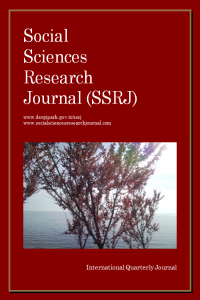Güney Kafkasya da Ekonomi Yoluyla Çatışmaların Azaltılması
Çalışma bölgedeki ülkeler arasındaki çatışmaların potansiyel ekonomik ilişkiler üzerindeki etkilerini incelemeye yöneliktir. Modellerde çekim alanı modellemesi kullanılmıştır Panel veri ekonometrisi metotlarıyla bölgeye ait küresel çekim alanı parametreleri hesaplanmaya çalışılmıştır. Bölgesel çatışmalar modelde bir gölge değişken yardımıyla gösterilmiştir. Sonuç olarak gölge değişken yardımıyla elde edilen CONFLICT adı verilen çatışma katsayısı -10.736’dır. Bunun manası çatışmaların ihracat üzerinde düşürücü bir etkisi olduğudur. Yani çatışma tek başına çatışan ülkelerin ticaretini 45 milyon dolar düşürmektedir. Bu rakamlar ülkelerin diğer değişkenleri eklendiğinde daha da yüksek bir değere ulaşmaktadır. Bölgedeki irili ufaklı ülkeler göz önüne alındığında bu çok önemli bir rakam haline gelmektedir.
Anahtar Kelimeler:
Çatışma, Çekim Modeli, Güney Kafkasya, Dış ticaret, Panel Veri
Reducing the Conflicts in South Caucasus by Economy
This study has aimed to evaluate the economic effects of current and potential economic relations and conflicts of the region’s nations. For this reason, the conflicts have been quantified and included as a variable to the Gravity model that attempts to model the economic structure of the region in a lattice sample. While various gravity models on a regional and global scale have been developed before, none of these have taken into account the conflicts as variables. The model is region specific and unique. Global parameters have little impact. As such, revision of the section titled Gravity Models reveals the oversight patterns of the previous econometric models. In the final model derived, the parameters pertaining to the CONFLICT variable have a negative sign. In other words, conflict between two nations has a negative impact on foreign trade. This value is -10.736. Taking into account that dependent variable is logarithmic, it has been verified that a 1 unit change in this value will result in a 10.73% decrease in exports. When the inverse logarithm of this parameter is incorporated, it has been estimated that conflicts alone could impact a minimum estimate of 45 million dollar exports deficiency. Foreseeing that such deficiency will result in much higher loss due to the multiplier effect, the study attempts to calculate the incurred foreign trade loss with various national scenarios.
Keywords:
Conflict, Gravity Model, South Caucasus Foreign Trade, Panel Data,
___
- Ağacan, K. (2006). Güney Kafkasya. Stratejik Öngörü- Asam, Ankara.
- Baier S. L. ve Bergstrand, J. H. (2008). Estimating The Effects of Free Trade Agreements on International Trade Flows Using Mactching Econometrics. Journal of International Economics.
- Baltagı B.H., (1995). Econometric Analysis of Panel Data, England: John Wiley & Sons Ltd.
- Blank, S. (1998). Kafkasya Güvenliğinde Yeni Eğilimler, Avrasya Etütleri, No: 13, Spring.
- Bolkesjo, T. F. ve Buongiorno, J. (2006). Short-and Long-Run Exchange Rate Effects on Forest Product Trade: Evidence From Panel Data. Journal of Forest Economics, 11.
- Carrillo, C. ve Carmen, A. L. (2002). Trade Blocks and the Gravity Model: Evidence From Latin American Countries. Czarny, E. ve Sledziewska. Monopolistic Competition, Gravity Model and International Trade Between Continents.
- Elma, F. (02-05 Mayıs 2007). Azerbaycan’ın Son Dönem SosyoEkonomik Profili, Globalleşme Prosesinde, Qafqaz ve Merkezi Asya’lı. International Conference, Volume II, Qafqaz University Et Al, Baku, 586587.
- Elma, F. (2009). Küreselleşme Sürecinde Güney Kafkasya Demokrasi, Güvenlik ve İşbirliği Sorunu. Uluslararası Sosyal Araştırmalar Dergisi, The Journal of International Social Research, 2(6).
- Greene, W. H. (2003). Econometric Analysis. New Jersey: Prentice Hall.
- Grıffıts, W. E. R & Carte H. (1993). Learning and Practicing Econometrics, John Wiley, New York,
- Guisan, M. C. (2006). Effects of the Integration of Mexico Into Nafta on Trade, Industry, Employment and Economic Growth.
- Guisan, M. C. (2006) "İndustry, Foreign Trade And Development: Econometric Models Of Europe And North America.1965-2003";2006
- Guısan, M. C. (2007). Industry, Foreign Trade And Development: Econometric Models Of Africa, Asia And Latin America,1960-2003;2007. Hackl P. Einführung İn Die Ökonometrie. Wi Wirtschaft.
- Hackl P. Statistical Analysis And Forecasting Of Economic Structural Change; Springer Verlag
- Hsiao, C. (1986). Analysis of Panel Data. Cambridge University Press.
- Hüseynov, F. (2001). Avrupa Birliği- BDT Ülkeleri İlişkilerinin Hukuki Çerçevesi. Journal of Ankara University Faculty of Law, 50, P.2.
- Karagöz, K. (24-27 Nisan 2008). Türkiye’ye Doğrudan Yabancı Yatırım Girişleri: Belirleyici Faktörler ve Potansiyel. Uluslararası Sermaye Hareketleri ve Gelişmekte olan piyasalar Uluslararası Sempozyumu. Balıkesir Üniversitesi, Bandırma İktisadi Ve İdari Bilimler Fakültesi. Karagöz, K. Türkiye'ye Doğrudan Yabancı Yatırım Girişleri Belirleyici Faktörler. Tuik 16. İstatistik Araştırma Sempozyumu Bildiriler Kitabı; 220-230.
- Külebi, A. (2007). BDT’nin Geleceği ve Rusya AB İlişkileri, TUSAM, http://www.tusam.net, 29.10.2007.
- Paın, N., Mourougane, A. vd. (2005). The New OECD International Trade Model. OECD Economics Department Working Papers, 440.
- Pazarlıoğlu, M. V. (19-22 Eylül 2001) 1980-1990 Döneminde Türkiye’de İç Göç Üzerine Ekonometrik Model Çalışması, V.Ulusal Ekonometri Ve İstatistik Sempozyumu, Adana.
- Pazarlıoğlu, G. (24-25 Mayıs 2007). Telekomünikasyon Yatırımları ve Ekonomik Büyüme: Panel Veri Yaklaşımı; 8. Türkiye Ekonometri ve İstatistik Kongresi – İnönü Üniversitesi Malatya.
- Sümer, K. K. (2009). AB Sürecinde Dış Ticaret Modelleme Tekniklerine Ekonometrik Yaklaşımlar. İstanbul 2009.
- Tarı, R. (2010). Ekonometri. Umuttepe Yayınları 10. Baskı.
- Tatoğlu, F. (2012). Panel Veri Ekonometrisi; Beta Basım A.Ş.; Istanbul.
- Uçal, H. ve Görmüş, Ş. (2007). Türkiye ile Güney Kıbrıs Arasındaki Potansiyel Ticaretin Çekim Teorisi Yöntemi İle Tahmini.
- Yayın Aralığı: Yılda 4 Sayı
- Yayıncı: Denta Florya ADSM Limited Company
